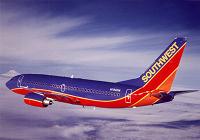The battleground among low-cost carriers has never been so stretched. Where once it was easy to split the market into either low-cost or network carrier camps, the lines have long since been blurred. Now even among the low-cost carriers themselves, the proposition can differ widely, whether it be frequent flyer schemes, distribution platforms, onboard services, codeshares or even fully-fledged alliance membership.
On the one hand categorising airlines as a low-cost carrier probably only really matters to the media; it makes it easier for people like myself to brand a carrier as standing in one camp or another. Air Berlin, after all, has never described itself as a low-cost carrier – so its evolution into an alliance member with oneworld arguably should not have been a surprise. Others tried to dodge being categorised in traditional camps at all; Virgin Blue for example in 2005 dubbed itself a New World Carrier.
But the upscale evolution among low-cost carriers, and its potential impact on its fundamentals, was one of the under-currents during the recent World Low Cost Airlines Congress in London. And what is clear is more than ever is no one size fits all.
ARCHIVE INTERVIEW |
|---|
 |
Read the Airline Business cover interview from June 2010 with Vueling chief executive Alex Cruz here |
“The market conditions have evolved. I don’t believe the rest of the carriers that are fundamentalists will be able to continue forever [without evolving],” says Cruz.
While his own airline Vueling is among those evolving and already has some mainstream characteristics, such as GDS distribution, Cruz insists this will only be done on the low-cost carrier’s terms. “Number one [priority] is to have the lowest possible cost base. Period,” he says. “Then keep evolving the product….so long as we are not compromising the first premise.” While he does not consider Vueling to be a fundamentalist low-cost carrier in outlook, he adds: “I do need to be fundamentalist about the cost-base.”
This is one area all low-cost carrier executives appear to agree. But what is noticeable is the fundamentals of the low-cost business can differ depending where in the world or maturity cycle you are. For example, secondary airports have fuelled much of the low-cost growth in the European and American markets, but in other parts of the world such opportunities are more limited.
“Australia is a bit different,” notes former bmibaby chief and Tiger Airways Australia’s new managing director, Crawford Rix. “When you fly from nowhere to nowhere, unlike in Europe, you really are flying nowhere to nowhere. It’s a very different environment we operate in.”
But at the same time the environment does offer its own benefits. “As we grow our fleet, there are some great opportunities to fly overnight in Australia and by doing that we will up our utilisation,” he says.
FlyDubai’s chief executive Ghaith Al Ghaith points to a similar situation in his region. “The fact you don’t have secondary airports means that will not allow you to operate to cheaper airports is one issue that is different. But the positive side is our airports in the region are open 24 hours a day, so we can mount utilisation around the clock and our utilisation is always going to be better [than other regions]. That is a great advantage.”
In Europe low-cost carriers are increasingly present at more mainstream airports and even cost-crusader Ryanair has made recent moves into higher yielding more mainstream airports of late, such as its newly launched base at Barcelona El Prat airport.
“In Europe we have been living through a phenomenal passage of secondary airport growth,” notes Vueling’s Cruz. “Part of that growth has been funded by public money and this has driven strong passenger growth.” But he questions what the impact might be should the new stranglehold on public purse strings in Europe hit these airports: “If the money goes away, will the passengers go away?”
Have low-cost carriers come of age? |
|---|
Read the Airline Business analysis from earlier this year on the low-cost airline sector, including the top ten airlines by revenue |
But Pereira believes it retains its key low-cost fundamentals like operating a single fleet type and 95% of flights being less than three hours. “We're shifting, but we are keeping the basics. Our cost base is going back to the 2006 pre-Varig levels. Costs [this year] will be slightly lower than 2006 levels,” he says. “The model still has a low-cost structure. If you keep to the original values, it is not going to destroy the model, it is going to evolve it.”
READ MORE |
|---|
 |
Southwest answers US legacy carrier consolidation with AirTran buy |
“We’ll be close to 700 aircraft [combined],” explains Southwest’s executive vice president, strategy and planning, Bob Jordan. “When you get to a certain size, the key is to be able to do things efficiently. The challenge you always have is doing small things in small numbers.”
But Jordan adds: “We haven’t shifted in the key elements. Those things never changed. [Over the years] we have refined our processes.”
ARCHIVE INTERVIEW |
|---|
 |
Read the Airline Business cover interview from May 2010 with Air Arabia chief executive Adel Ali here |
“One of the things we have learnt is not to come in with any pre-conceived ideas. Our journey has been one of a lot of experimentation and learning…and we continue to do so,” he says. The carrier, which has just secured access to Tokyo’s Haneda Airport and will launch thrice-weekly flights from Kuala Lumpur in December, is also embarking on steps to separate out from its parent with a public listing earmarked for next year. Azran says under this structure it can be even bolder in its experimentation.
With more carriers eyeing the long-haul field and budget carriers continuing to push the envelope of revenue generation, service offerings and passenger connections, the low-cost sector has and continues to evolve. “I think it has been changing for a long time,” says Adel Ali, chief executive at pioneering Middle East low-cost carrier Air Arabia. “The world was a different place then and it is a different place today. Low-cost carriers are changing to ensure they keep their costs down.”
Source: Airline Business



















